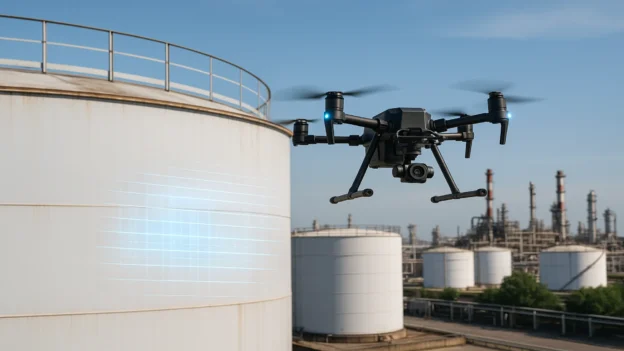The use of drones and robots has become more commonplace in the world today and has even started impacting the inspections on Aboveground Storage Tanks (ASTs). I wrote an article last year that was more generic and had some minor speculation of what might happen in the future. This article will discuss what inspections are required, what can be done today with a drone and/or a robot (walking, crawling, swimming), and what might be done relatively soon, and more importantly practical.
Currently, drones are used for detection of emissions from ASTs and facilities and overall site inspections. Drones are often used today to take videos of tanks, perform ultrasonic spot (UT) inspections, pressure wash tanks and even sometimes even paint ASTs.
Per API Standard 653, the following inspections are required: Routine In-service (monthly), External (5-year visual), Ultrasonic (15-year UT), and internal (out of service).
Monthly inspections can be performed by anyone that per API 653 “should be knowledgeable of the storage facility operations, the tank, and the characteristics of the product stored”. This is the only inspection on ASTs per API 653 that can be performed by someone other than an API 653 authorized inspector.
There are Owner/Operators that are using drones to “look” at their ASTs. However, in my opinion, there is a potential issue with this approach as API 653 doesn’t mention drones or robots or any other method for performing the visual inspections currently. It should also be noted that there is a list of items in API 653, that, if observed, need to be evaluated by an authorized inspector. While drones can perform these visual inspections, there needs to be more done to comply with API 653.
Robots that can “walk” are another potential way to collect video and pictures. However, there are some potential issues with using a robot. First in my mind is the cost of the robot. While I am sure the costs will continue come down and the capabilities will increase, I’m not sure that it will make sense anytime soon. In addition, there are often obstacles that limits the ability of current robots to “walk” around the ASTs. Also, for many ASTs, electrical area classifications will limit the viability of using a robot.
Both the 5-year visual and 15-year UT inspections are required to be performed by an API 653 inspector. Drones and robots can both be used to assist in these inspections, but their practicality varies. Each of the inspections will be discussed in more detail along with how drones and robots might be able to help.
For the 5-year visual, a drone can certainly take video of an AST to be reviewed by an authorized API 653 inspector. Again, I’m not convinced of the practicality or cost effectiveness. Again, API 653 does not currently address an authorized inspector who does not perform the visual inspection themselves.
For a 15-year UT, one advantage of using a drone or a crawling type of robot is the ability to take UT readings at locations that cannot be easily accessed by an API 653 inspector under normal conditions. From a practical standpoint, I’m not convinced that the extra data is worth the extra costs and time.
The last, and in my opinion, the most important inspection, is the internal inspection. These inspections are traditionally performed by emptying the tank of product, cleaning, and then sending people and equipment into the AST. The 3 primary purposes of an internal inspection are:
- Ensure that the bottom is not severely corroded or leaking.
- Gather data for minimum bottom and shell thickness.
- Identify and evaluate bottom settlement.
First, drones are obviously not practical due to the AST being full of liquid. However, robots, both crawling and swimming types, have been used for almost 30 years to inspect ASTs while they are in service. While robots have limits on the type of products they can be used in, today’s robots are certainly a more viable option than in the past.
As the various technologies used by robots continue to improve, I think the use of robots to perform internal inspections will increase. You may find it surprising that robots (and other on-stream inspection methods) have been allowed by API 653 for more than 25 years to perform the internal inspections without taking ASTs out of service.
So, what is an Owner/Operator to do? Tank inspections are still primarily performed by people, but the use of drones and robots will continue to increase. API 653 and regulations will need to adapt to technological advancements. Owner/Operators must evaluate the cost versus value of these technologies versus traditional methods.
This article was developed by specialist Earl Crochet and published as part of the fifth edition of Inspenet Brief magazine August 2025, dedicated to technical content in the energy and industrial sector.

